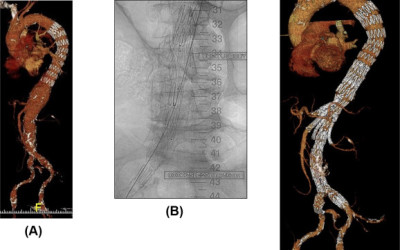Ref. EJVES Nov 2015
The work and results coming from ST Thomas’ Unit in London are, to say the least, very encouraging. SCIs are not only preventable, but they are SIGNIFICANTLY reversible! This is quite encouraging when advising patients. We of course has to remember one important point: attention to details by the WHOLE team, not only by the surgeon!
Here are some details:
- Sixty-nine patients (median age 73 years, 52 male; Crawford classification type I [n = 4], type II [n = 11], type III [n = 33], type IV [n = 14], type V [n = 7]) underwent endovascular TAAA repair.
- Twelve patients developed neurological symptoms/signs related to SCI
- This was successfully reversed in eight patients, leaving four (5.8%) with permanent paraplegia.
- The median length of aorta covered was not significantly different in the 12 patients who developed SCI compared with the cohort that did not. see picture!
- Eleven of the patients who developed SCI had an intraoperative mean arterial pressure (MAP) below 80 mmHg. Cutaneous atheroemboli were noted in half of the patients in the SCI group compared with 11% of the non-SCI group (p < .05).
- Strategies used to reverse SCI included raising MAP, cerebrospinal fluid drainage, angioplasty of stenosed internal iliac arteries, and restoring perfusion to the aneurysm sac.
Picture: notice the extent of aortic coverage. This did not affect the incidence of SCI. Picture for education purpose and news reporting only and is not reusable.

